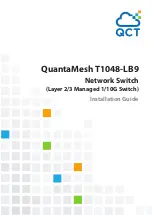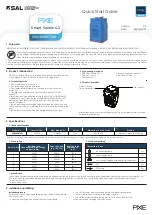
OSPF Configuration
247
After the summarization of imported routes is configured, if the local router is an
autonomous system border router (ASBR), this command summarizes the imported
Type-5 LSAs in the summary address range. When NSSA is configured, this command
will also summarize the imported Type-7 LSA in the summary address range.
If the local router works as an area border router (ABR) and a router in the NSSA, this
command summarizes Type-5 LSAs translated from Type-7 LSAs. If the router is not
the router in the NSSA, this summarization is disabled.
Configuring OSPF Virtual Link
According to RFC2328, after the area division of OSPF, the backbone is established
with an area-id of 0.0.0.0. The OSPF routes between non-backbone areas are
updated with the help of the backbone area. OSPF stipulates that all the
non-backbone areas should maintain the connectivity with the backbone area, and at
least one interface on the ABR should fall into the area 0.0.0.0. If an area does not
have a direct physical link with the backbone area 0.0.0.0, a virtual link must be
created.
If physical connectivity cannot be ensured due to the network topology restrictions, a
virtual link can be used to meet the requirements of RFC2328. The virtual link refers
to a logic channel set up through the area of a non-backbone internal route between
two ABRs. Both ends of the logic channel should be ABRs and the connection can
take effect only when both ends are configured. The virtual link is identified by the ID
of the remote router. The area, which provides the ends of the virtual link with a
non-backbone area internal route, is called the transit area. The ID of the transit area
should be specified during configuration.
The virtual link is activated after the route passing through the transit area is
calculated, which is equivalent to a P2P connection between two ends. Therefore,
similar to the physical interfaces, you can also configure various interface parameters
on this link, such as an hello timer.
The "logic channel" means that the multiple routers running OSPF between two
ABRs only take the role of packet forwarding (the destination addresses of the
protocol packets are not these routers, so these packets are transparent to them and
the routers forward them as common IP packets). The routing information is directly
transmitted between the two ABRs. The routing information refers to the type-3 LSAs
generated by the ABRs, for which the synchronization mode of the routers in the area
will not be changed.
Perform the following configuration in OSPF Area View.
The
area_id
and
router_id
have no default value.
By default, hello timer is 10 seconds, retransmit 5 seconds, trans-delay 1 second, and
the dead timer is 40 seconds.
Table 238
Configuring OSPF Virtual Link
Operation
Command
Create and configure a virtual link
vlink-peer
router_id
[
hello
seconds
|
retransmit
seconds
|
trans-delay
seconds
|
dead
seconds
|
simple
password
|
md5
keyid
key
]*
Remove the created virtual link
undo
vlink-peer
router_id
Содержание 5500 SI - Switch - Stackable
Страница 24: ...24 ABOUT THIS GUIDE...
Страница 30: ...30 CHAPTER 1 GETTING STARTED Figure 3 Setting up a New Connection Figure 4 Configuring the Port for Connection...
Страница 50: ...50 CHAPTER 1 GETTING STARTED...
Страница 54: ...54 CHAPTER 2 ADDRESS MANAGEMENT CONFIGURATION...
Страница 78: ...78 CHAPTER 3 PORT OPERATION...
Страница 88: ...88 CHAPTER 4 XRN CONFIGURATION...
Страница 122: ...122 CHAPTER 8 VLAN VPN CONFIGURATION...
Страница 216: ...216 CHAPTER 15 SSH TERMINAL SERVICES...
Страница 268: ...268 CHAPTER 16 IP ROUTING PROTOCOL OPERATION...
Страница 308: ...308 CHAPTER 17 NETWORK PROTOCOL OPERATION...
Страница 349: ...349...
Страница 350: ...350 CHAPTER 18 MULTICAST PROTOCOL...
Страница 522: ...522 CHAPTER 22 FILE SYSTEM MANAGEMENT...
Страница 584: ...584 CHAPTER 30 PASSWORD CONTROL CONFIGURATION OPERATIONS...
Страница 600: ...600 CHAPTER 31 MSDP CONFIGURATION...
Страница 614: ...614 CHAPTER 32 CLUSTERING...
Страница 670: ...670 CHAPTER C AUTHENTICATING THE SWITCH 5500 WITH CISCO SECURE ACS...
















































